The Digital Shop® Blog
4 Pillars to Build a Strong Online Presence For Your Auto Repair Shop
81% of American consumers will do online research before considering a major purchase and where to spend their dollar. That means, in order to turn your website into an appointment-generating machine, you'll have to make it easy to find your shop online - because that is where your customers and your competitors are.
Building a strong digital presence requires four key components - we break them down for you here.
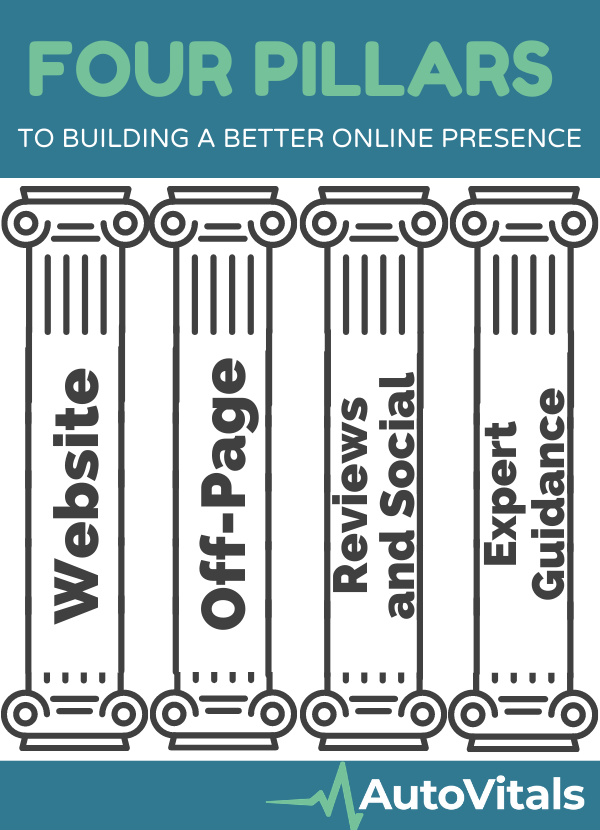
Pillar 1 - Website

There are two purposes to a website:
- Drive business through appointments and phone calls. Make it easy for your customers to be in touch.
- Drive your brand by explaining who you are and what you do
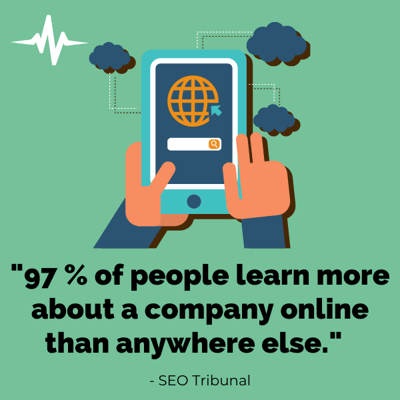
There are also two audiences your site needs to please:
- Motorists - They want to see who you are and determine if they're going to do business with you. Can they easily schedule an appointment? Can they find your address, phone number, or directions to the shop?
- Google - Representing more than 86% of the search engine market share, Google is looking to provide users with relevant, high-quality results. To do that, Google must trust a website or business. They determine that trust by evaluating the website structure - is it easy to use? Does the content meet the EAT (expertise, authority, and trust) requirements?
Pillar 2 - Off-Page
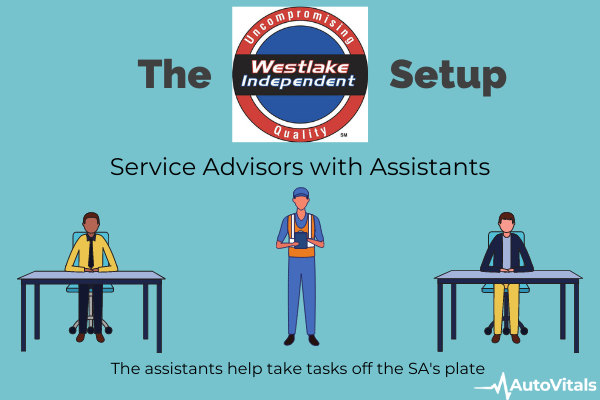
Did you know that more than half of all Google searches don’t lead to a click into a website? This is because of things like Google My Business (GMB), which provides a snapshot of your business and addresses most of the information that people are looking for, meaning there is no need to click into a website.
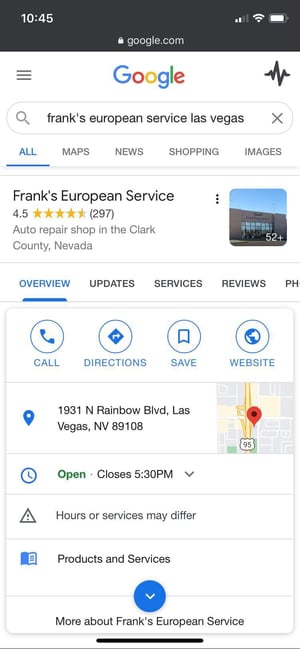
GMB for Frank's European Service in Las Vegas, Nevada.
However, when using GMB, your business information must be correct and consistent.
Search engines look for NAP consistency, which stands for Name, Address, and Phone number. If your business has other listings with varying addresses, they may think there is something fishy about your business. As mentioned above, trust is vital in Google rankings, and if you have different addresses listed on GMB than you do on your website, you may not rank well.
Pillar 3 - Reviews and Social Media
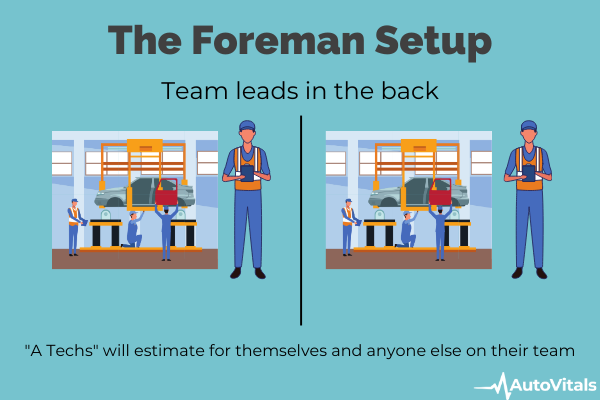
Reviews
If someone spray-painted an insult on the front of your repair shop, would you leave it there? If you aren’t responding to reviews, you may be damaging your reputation.
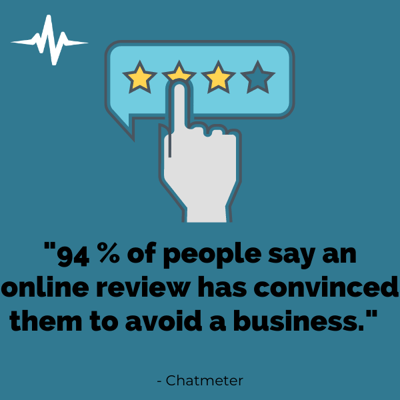
According to a recent Chatmeter report, “71% of consumers say they’re more likely to use a business that has responded to their existing reviews.” Even more staggering, “94% of people say an online review has convinced them to avoid a business.”
You have spent time, money, and effort establishing your business and website. If a motorist finds your reviews and decides not to do business with your shop, your hard work won’t pay off.
There are three primary audiences for your reviews and responses:
- The reviewer - A motorist has a compliment, concern, or complaint. Did you respond? How did you address any concerns or complaints? Have you turned a negative relationship around so they can update or remove their review?
- The prospective customer - They are looking through reviews to see, how do you handle negative reviews, what is your average rating, how many reviews does the shop have, how recent are the reviews?
- You (shop owner) - Reviews can provide a lot of information for auto repair shops if you are willing to look for patterns or themes. Do all your negative reviews have something in common? Use this information as an opportunity to take feedback and make changes and fixes to improve.
Social Media
Social media is another terrific way to interact with your customers.
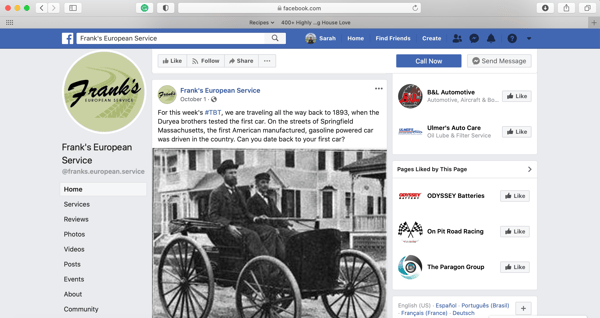
It can:
- Drive brand awareness
- Tell your customers who you are, what’s important to you, what they can expect
- Drive traffic to your website
- Allow your shop to stay front-of-mind in-between their visits
- Occupy SERP (search engine results page) real estate
Each platform has its own benefits. Three of the largest include:
- Facebook is the most heavily used and has the largest volume of users.
- Instagram is image-focused and allows trends and topics to be searched via hashtag.
- Twitter is used by national brands as a great place for customer support. The platform moves very quickly.
Pillar 4 - Expert Guidance


“The difference between vision and a goal is the finish line.”
- Simon Sinek
The best way to the finish line is with a clear, defined, and guided path. Here are the keys to success:
- Define your goals. Don’t just use hope. Do you want to increase sales? Get more leads? Open a new shop?
- Know your audience. When you know who your clients are, you can tailor your messaging and advertising.
- Focus on specialties. Do you have a Master Technician in the shop? Do you do fleet work? Make sure to highlight those specialties.
- Measure results. You aren’t going to know how effective you were until you track your results. Using key performance indicators (KPIs), you can measure the success of your processes.
- Listen to your customers. Pay attention to reviews, take clues from feedback, and turn it into process improvements.
- Amplify your content. This can take different forms, including running Facebook ads or using paid search to bring awareness to something your shop is doing.
- Ongoing optimization. Ensure that your content is continually updated to boost your search engine ranking
Let AutoVitals help
Measuring whether you are satisfying Google and motorists, determining how you are ranking and showing on SERP, responding to reviews, and keeping up with social media in addition to running a shop makes for a long to-do list for success. But you don’t have to do it alone. AutoVitals has a team of experts to help you build a strong and successful online presence.
The Digital Shop.X (DS.X) offers a comprehensive solution to ensure your shop’s success, including:
- A website built to excel in organic searches
- A comprehensive NAP/GMB strategy
- Reputation Management
- Organic Social Media Publishing
- Dedicated Digital Marketing Experts
DS.X is also integrated with Digital Vehicle Inspections (DVI.X), shop workflow, and CRM.
Read On
5 Marketing Strategies to Bring in More Customers to Your Auto Repair Shop
Marketing can feel like a broad task. Though important for any small business, it can be hard to...Everything An Auto Repair Owner Should Know About Optimizing Facebook
Facebook can be a powerful marketing tool that helps support your auto repair shop. With its 260...3 Ways to Ensure Your Auto Repair Shop Website Stands Out
As more and more research and buying decisions move online, your auto repair shop's online presence...Posts by Topic
- Digital Shop (47)
- auto repair shop (44)
- automotive shop management software (31)
- Auto Shop (29)
- Autovitals (29)
- DVI (29)
- shop management (25)
- workflow (18)
- Digital Marketing (17)
- BCP (16)
- CRM (15)
- auto repair shop marketing (15)
- Staff Buy-In (14)
- Best Practice (13)
- aro (13)
- Consistency (11)
- Digital Vehicle Inspection (11)
- Process Change (11)
- Tech (11)
- service advisor (11)
- COVID-19 (10)
- KPIs (10)
- Shop Culture (10)
- Websites (10)
- AutoVitals News (8)
- Integration (8)
- Website (8)
- automotive shop software (8)
- Announcement (7)
- Automotive Technician (7)
- Press Release (7)
- Partners (6)
- auto repair marketing company (6)
- auto repair shop SEO (6)
- New Features (5)
- auto repair services (5)
- best auto repair software (5)
- Coaching (4)
- Customer Reviews (4)
- Paperless (4)
- Reviews (4)
- auto shop management (4)
- multishop (4)
- smartflow (4)
- Automotive Technician Shortage (3)
- DRIVE Shops (3)
- Digital Shop Conference (3)
- Industry Events (3)
- Meineke (3)
- NAPA (3)
- Shop-Ware (3)
- auto parts inventory (3)
- auto shop efficiency (3)
- automotive repair invoice app (3)
- creative (3)
- drop off (3)
- training (3)
- web based auto repair software (3)
- Automotive text messaging (2)
- Bookkeeping for auto repair shops (2)
- POS (2)
- Picture Edits (2)
- Protractor (2)
- Recruiting (2)
- RepairPal (2)
- TeE-Times (2)
- The Digital Shop Talk Radio (2)
- inventory management (2)
- loyalty (2)
- Auto mechanic interview questions (1)
- BayIQ (1)
- Building a Bench (1)
- Campaign Manager (1)
- Canned Jobs (1)
- Case Study (1)
- Community (1)
- GMB (1)
- Guided Inspection (1)
- Hiring (1)
- Interview (1)
- MRT (1)
- Motorist Approval (1)
- Q&A (1)
- Remote Work (1)
- Service Writer (1)
- TVP (1)
- Tekmetric (1)
- The Digital Shop Summit (1)
- Who's in our shop? (1)
- auto parts (1)
- auto repair shop financing (1)
- best auto repair shop websites (1)
- estimate (1)
- financing (1)
- inflation (1)
- marketing plan (1)
- parts catalog (1)
- pricing (1)
- retention (1)
- script (1)
- social media (1)
- social media marketing (1)




